 Technology peripherals
Technology peripherals
 AI
AI
 The Chinese team won the best paper and best system paper awards, and the CoRL research results were announced.
The Chinese team won the best paper and best system paper awards, and the CoRL research results were announced.
The Chinese team won the best paper and best system paper awards, and the CoRL research results were announced.
Since it was first held in 2017, CoRL has become one of the world's top academic conferences in the intersection of robotics and machine learning. CoRL is a single-theme conference for robot learning research, covering multiple topics such as robotics, machine learning and control, including theory and application
The 2023 CoRL Conference will be held in November It will be held in Atlanta, USA from the 6th to the 9th. According to official data, 199 papers from 25 countries were selected for CoRL this year. Popular topics include operations, reinforcement learning, and more. Although CoRL is smaller in scale than large AI academic conferences such as AAAI and CVPR, as the popularity of concepts such as large models, embodied intelligence, and humanoid robots increases this year, relevant research worthy of attention will also be presented at the CoRL conference.
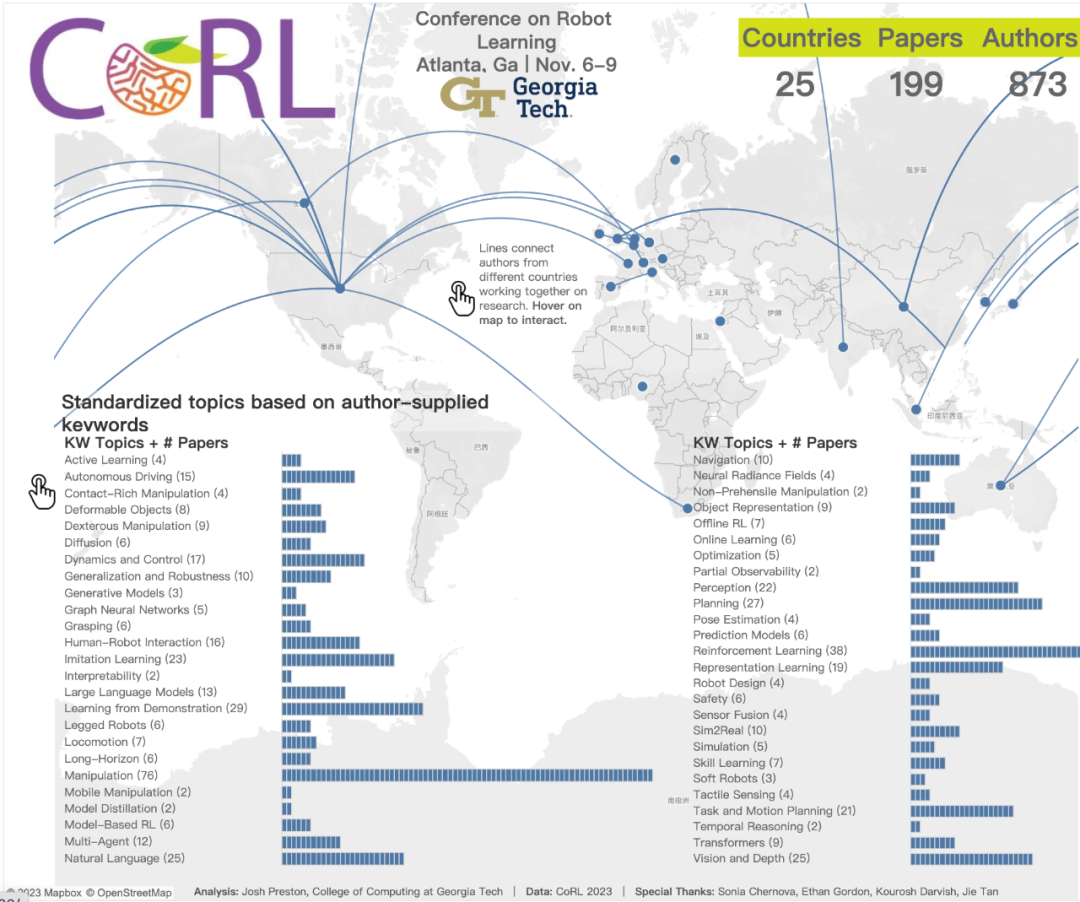
Currently, CoRL 2023 officials have announced the Best Paper Award, Best Student Paper Award, Best System Paper Award and other awards. Next, we will introduce these award-winning papers to you.
Best Paper
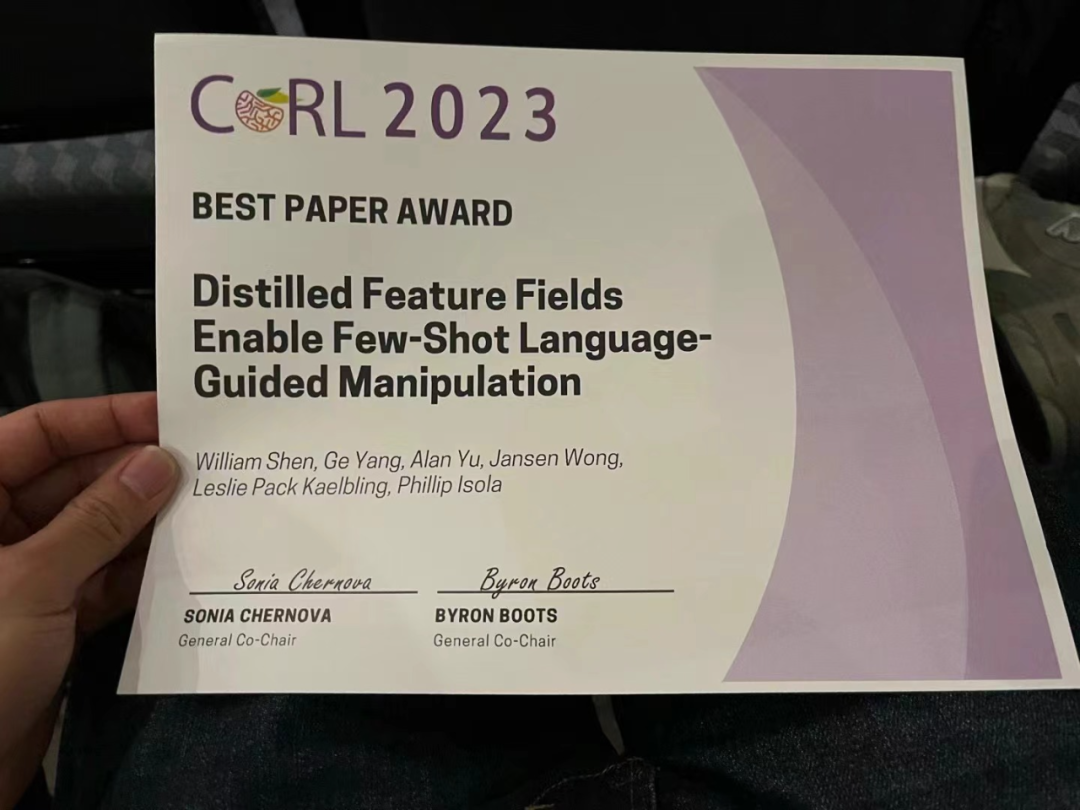
- ##Thesis: Distilled Feature Fields Enable Few-Shot Language- Guided Manipulation
- Authors: William Shen, Ge Yang, Alan Yu, Jensen Wong, Leslie Pack Kaelbling, Phillip Isola
- Institution: MIT CSAIL , IAIFI
- Paper address: https://openreview.net/forum?id=Rb0nGIt_kh5
Research Overview: Currently, self-supervised learning and language supervised learning in image models have incorporated rich global knowledge, which is very critical to the generalization ability of the model. However, image features only contain two-dimensional information. We learned that in robotics tasks it is very important to have an understanding of the geometry of three-dimensional objects in the real world
By using Distilled Feature Field (DFF), This research combines precise 3D geometry with rich semantics from a 2D base model to enable robots to leverage rich visual and language priors in the 2D base model to complete language-guided operations
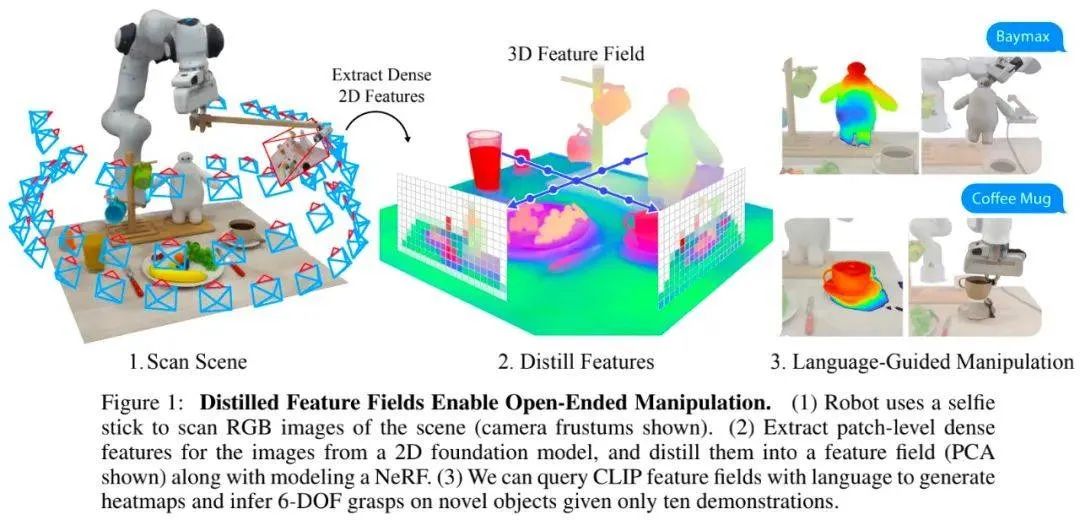
Specifically, this study proposes a few-shot learning method for 6-DOF grabbing and placing, and leverages strong spatial and semantic priors Generalize to unseen objects. Using features extracted from the vision-language model CLIP, this study proposes an open-ended natural language instruction to operate on new objects and demonstrates the ability of this method to generalize to unseen expressions and novel objects. .
The two co-authors of this paper are William Shen and Yang Ge, members of the CSAIL "Embodied Intelligence" team. Yang Ge is a co-author of the 2023 CSAIL Embodied Intelligence Symposium. Organizer.
I learned that "Heart of the Machine" has introduced this research in detail, please read "How powerful are robots supported by large models? MIT CSAIL&IAIFI uses natural language to guide robots to grasp objects 》
Best Student Paper
- Paper: Robots That Ask For Help: Uncertainty Alignment for Large Language Model Planners
- Author: Allen Z. Ren, Anushri Dixit, Alexandra Bodrova, Sumeet Singh, Stephen Tu, Noah Brown, Peng Xu, Leila Takayama, Fei Xia, Jake Varley, Zhenjia Xu, Dorsa Sadigh, Andy Zeng, Anirudha Majumdar
- Institution: Princeton University, Google DeepMind
- Paper address: https://openreview.net/forum ?id=4ZK8ODNyFXx
Large language model (LLM) is a technology with broad application prospects, especially in the field of robotics. However, although LLM shows great potential in step-by-step planning and common-sense reasoning, it also suffers from some illusion problems
Based on this, this study proposes a new framework—— KnowNo, for measuring and aligning uncertainty in LLM-based planners. It enables the LLM to realize what information is unknown and to ask for help when needed.

KnowNo is based on conformal prediction theory, which provides statistical guarantees of task completion and can minimize human intervention in multi-step planning tasks
This study tested KnowNo with various modes of uncertain tasks (including spatial uncertainty, numerical uncertainty, etc.) in various simulated and real robot experiments. Experimental results show that KnowNo performs well in improving efficiency and autonomy, outperforms baselines, and is safe and trustworthy. KnowNo can be used directly in LLM without model fine-tuning, providing an effective lightweight solution to model uncertainty and complementing the increasing capabilities of the underlying model.
Best System Paper
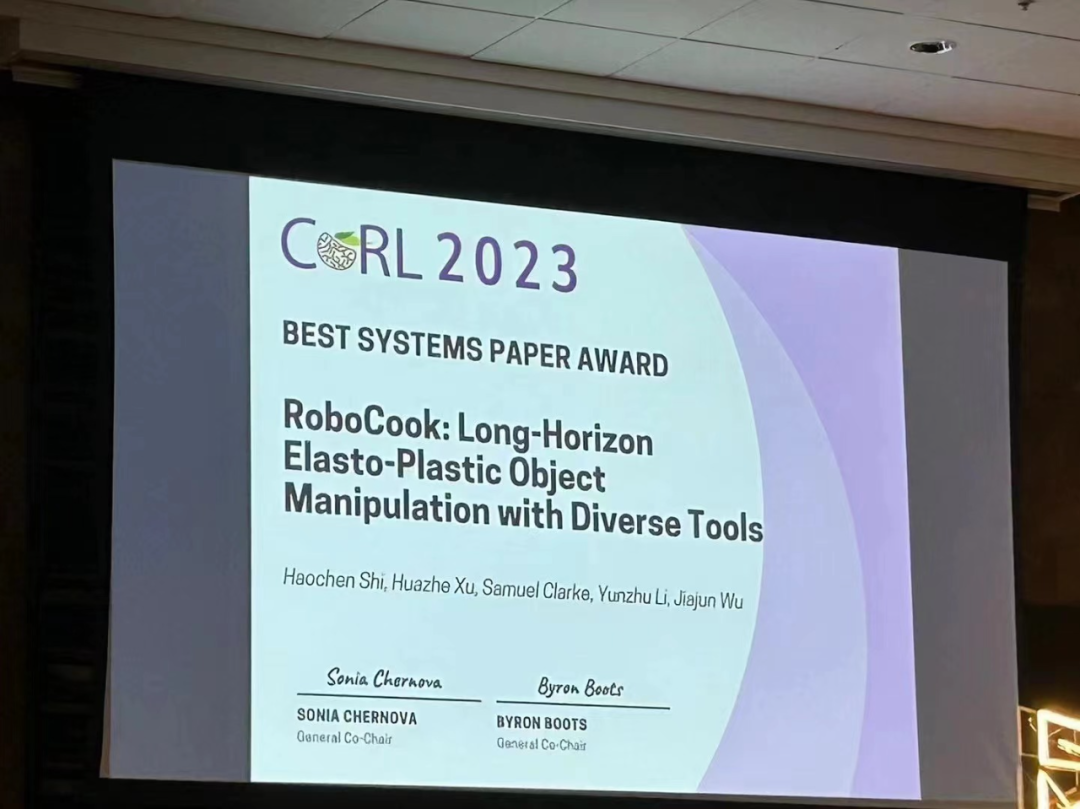
- ##Paper: RoboCook: Long-Horizon Elasto-Plastic Object Manipulation with Diverse Tools
- Authors: Haochen Shi, Huazhe Xu, Samuel Clarke, Yunzhu Li, Jiajun Wu
- Institution: Stanford University, UIUC ##Paper address:
- https://openreview.net/forum?id=69y5fzvaAT

The study shows that with just 20 minutes of real-world interaction data per tool, RoboCook can learn and manipulate the robotic arm to complete some complex, long-term elastic-plastic behaviors Object manipulation tasks, such as making dumplings, alphabet cookies, etc.
According to experimental results, RoboCook's performance is significantly better than the existing SOTA method, and it can still show stability in the face of severe external interference and adapt to different materials. The ability is also better
It is worth mentioning that the co-authors of this paper are Haochen Shi, a doctoral student from Stanford University, a former postdoctoral researcher at Stanford University, and a current cross-disciplinary researcher at Tsinghua University. Huazhe Xu, assistant professor at the Institute of Information Science, and one of the authors of the paper is Wu Jiajun, an alumnus of Yao Class and assistant professor at Stanford University.
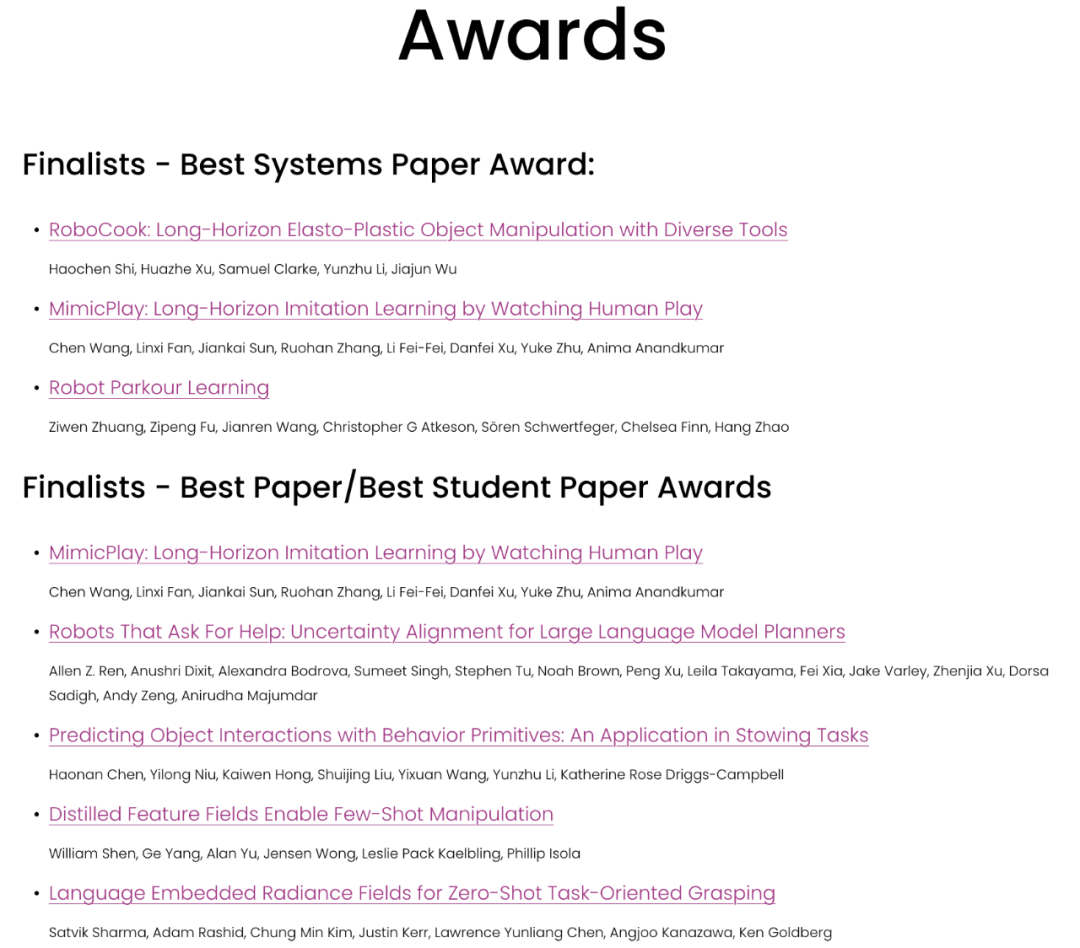
The above is the detailed content of The Chinese team won the best paper and best system paper awards, and the CoRL research results were announced.. For more information, please follow other related articles on the PHP Chinese website!

Hot AI Tools

Undresser.AI Undress
AI-powered app for creating realistic nude photos

AI Clothes Remover
Online AI tool for removing clothes from photos.

Undress AI Tool
Undress images for free

Clothoff.io
AI clothes remover

AI Hentai Generator
Generate AI Hentai for free.

Hot Article

Hot Tools

Notepad++7.3.1
Easy-to-use and free code editor

SublimeText3 Chinese version
Chinese version, very easy to use

Zend Studio 13.0.1
Powerful PHP integrated development environment

Dreamweaver CS6
Visual web development tools

SublimeText3 Mac version
God-level code editing software (SublimeText3)

Hot Topics
 1377
1377
 52
52
 What is the syntax for adding columns in SQL
Apr 09, 2025 pm 02:51 PM
What is the syntax for adding columns in SQL
Apr 09, 2025 pm 02:51 PM
The syntax for adding columns in SQL is ALTER TABLE table_name ADD column_name data_type [NOT NULL] [DEFAULT default_value]; where table_name is the table name, column_name is the new column name, data_type is the data type, NOT NULL specifies whether null values are allowed, and DEFAULT default_value specifies the default value.
 SQL Clear Table: Performance Optimization Tips
Apr 09, 2025 pm 02:54 PM
SQL Clear Table: Performance Optimization Tips
Apr 09, 2025 pm 02:54 PM
Tips to improve SQL table clearing performance: Use TRUNCATE TABLE instead of DELETE, free up space and reset the identity column. Disable foreign key constraints to prevent cascading deletion. Use transaction encapsulation operations to ensure data consistency. Batch delete big data and limit the number of rows through LIMIT. Rebuild the index after clearing to improve query efficiency.
 Use DELETE statement to clear SQL tables
Apr 09, 2025 pm 03:00 PM
Use DELETE statement to clear SQL tables
Apr 09, 2025 pm 03:00 PM
Yes, the DELETE statement can be used to clear a SQL table, the steps are as follows: Use the DELETE statement: DELETE FROM table_name; Replace table_name with the name of the table to be cleared.
 phpmyadmin creates data table
Apr 10, 2025 pm 11:00 PM
phpmyadmin creates data table
Apr 10, 2025 pm 11:00 PM
To create a data table using phpMyAdmin, the following steps are essential: Connect to the database and click the New tab. Name the table and select the storage engine (InnoDB recommended). Add column details by clicking the Add Column button, including column name, data type, whether to allow null values, and other properties. Select one or more columns as primary keys. Click the Save button to create tables and columns.
 How to deal with Redis memory fragmentation?
Apr 10, 2025 pm 02:24 PM
How to deal with Redis memory fragmentation?
Apr 10, 2025 pm 02:24 PM
Redis memory fragmentation refers to the existence of small free areas in the allocated memory that cannot be reassigned. Coping strategies include: Restart Redis: completely clear the memory, but interrupt service. Optimize data structures: Use a structure that is more suitable for Redis to reduce the number of memory allocations and releases. Adjust configuration parameters: Use the policy to eliminate the least recently used key-value pairs. Use persistence mechanism: Back up data regularly and restart Redis to clean up fragments. Monitor memory usage: Discover problems in a timely manner and take measures.
 How to create an oracle database How to create an oracle database
Apr 11, 2025 pm 02:33 PM
How to create an oracle database How to create an oracle database
Apr 11, 2025 pm 02:33 PM
Creating an Oracle database is not easy, you need to understand the underlying mechanism. 1. You need to understand the concepts of database and Oracle DBMS; 2. Master the core concepts such as SID, CDB (container database), PDB (pluggable database); 3. Use SQL*Plus to create CDB, and then create PDB, you need to specify parameters such as size, number of data files, and paths; 4. Advanced applications need to adjust the character set, memory and other parameters, and perform performance tuning; 5. Pay attention to disk space, permissions and parameter settings, and continuously monitor and optimize database performance. Only by mastering it skillfully requires continuous practice can you truly understand the creation and management of Oracle databases.
 How to create oracle database How to create oracle database
Apr 11, 2025 pm 02:36 PM
How to create oracle database How to create oracle database
Apr 11, 2025 pm 02:36 PM
To create an Oracle database, the common method is to use the dbca graphical tool. The steps are as follows: 1. Use the dbca tool to set the dbName to specify the database name; 2. Set sysPassword and systemPassword to strong passwords; 3. Set characterSet and nationalCharacterSet to AL32UTF8; 4. Set memorySize and tablespaceSize to adjust according to actual needs; 5. Specify the logFile path. Advanced methods are created manually using SQL commands, but are more complex and prone to errors. Pay attention to password strength, character set selection, tablespace size and memory
 Monitor Redis Droplet with Redis Exporter Service
Apr 10, 2025 pm 01:36 PM
Monitor Redis Droplet with Redis Exporter Service
Apr 10, 2025 pm 01:36 PM
Effective monitoring of Redis databases is critical to maintaining optimal performance, identifying potential bottlenecks, and ensuring overall system reliability. Redis Exporter Service is a powerful utility designed to monitor Redis databases using Prometheus. This tutorial will guide you through the complete setup and configuration of Redis Exporter Service, ensuring you seamlessly build monitoring solutions. By studying this tutorial, you will achieve fully operational monitoring settings



